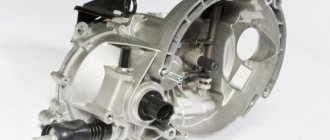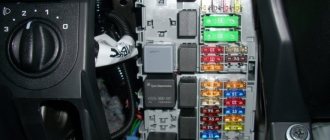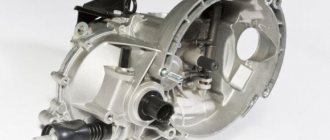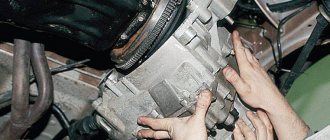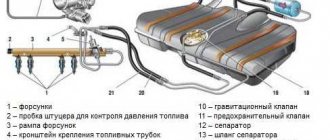The performance of the Lada Kalina gearbox is directly determined by the type of transmission substance used. The gearbox design requires regular monitoring of the oil level. The lubricant in the unit must also be replaced in a timely manner. Lada Kalina is equipped with manual and automatic transmissions. The option of equipping one or another gearbox determines the design and operational features of the vehicle.
The structure of a mechanical box on Kalina
The Lada Kalina manual transmission is a two-shaft design with 5 forward gears and 1 reverse gear. Synchronizers are installed on all forward gears. Structurally, the gearbox, differential and main gear are combined into one unit.
The manual transmission housing consists of several elements:
- clutch housing;
- gearbox housing;
- rear cover of the gearbox housing.
They are cast from aluminum alloys. When assembling, a sealant gasket with gasoline and oil resistant properties is used between the structural parts. There is a special magnet located in the clutch housing oil drain plug socket. It traps metal debris and prevents it from entering the Lada Kalina checkpoint.
The input shaft is represented by the drive gears in the block. There is constant engagement between them and the driven gears of the forward speeds. The secondary shaft of the Lada Kalina gearbox has a hollow structure, due to which oil is delivered to the driven gear area. The secondary shaft contains a removable main gear drive gear, driven gears, and front gear synchronizers.
Front (roller) and rear (ball) bearings are fixed on the shafts. The radial clearance in the front bearings is no more than 0.07 mm, in the rear bearings – 0.04 mm. The oil flow is directed into the shaft through the oil sump.
The driven gear of the Lada Kalina gearbox is attached to the flange of the two-satellite differential box. The box is connected to the atmosphere by a breather located at the top.
The gearbox control drive consists of:
- shift lever;
- spherical bearing;
- control rod;
- gear shift rod;
- gear shift mechanisms.
To block spontaneous gear shifting, jet thrust was introduced into the Lada Kalina box . At one end it is connected to the motor, and at the other to the base of the lever for changing gears.
What did you get?
The design of the gearbox was not only optimized and made more reliable, but also almost completely eliminated unpleasant vibrations on the lever and the car body. The backlash has become smaller and the shifts are clearer. It is worth noting that the use of a modernized gearbox on the Lada Granta and Lada Kalina 2 entailed an increase in the cost of these cars by an average of 5,000 rubles. By the way, the cable box is not installed on the Lada Priora; this car uses a 2180 manual transmission with rigid rods.
Let us remind you that according to reviews, the first copies of the modified gearbox were not entirely successful. The owners noticed a decrease in vibrations, but encountered a new problem: the box began to howl. After this, AVTOVAZ made changes to the design, but the sediment remained...
Keywords: Lada Granta gearbox | Lada Kalina gearbox
1 0 0 1 0 0
Share on social networks:
Reverse lock solenoid
The Kalina gearbox device is distinguished by the presence of a solenoid to block accidental or random engagement of reverse gear. The solenoid core has a protruding part that prevents the locking brackets from moving along the axes until reverse gear is engaged. The solenoid is controlled by a switch mounted on the lever.
The solenoid is located in the box housing, its lower left part. When the ring under the handle is raised, then the contacts are closed to supply voltage to the solenoid. Its core retracts and reverse gear can be engaged. This mechanism eliminates the possibility of mistakenly switching to reverse gear instead of first.
If the solenoid fails or the electrical circuit is damaged, engaging reverse gear becomes impossible. The solenoid will need to be replaced. It can be done at a service station or in a garage. When the solenoid is replaced, you will have to add oil to the gearbox. When the solenoid is turned out, a certain part of the liquid flows out.
If a malfunction is detected far from the place where the car is parked or where the car can be repaired, you will have to get there in emergency mode. For this:
- you need to unscrew the solenoid;
- Place the rod lock plug (from the gear shift fork) into the vacated hole.
When driving the vehicle, you must be careful not to engage reverse gear instead of first. The device diagram will help you install the solenoid on the gearbox yourself. The replacement itself is not a particularly complicated process.
Why is it important to know the layout of the Kalina manual transmission?
If extraneous sounds occur when switching gears, you need to look for the cause in the box. This is the first reason why you need to know the structure of the Kalina gearbox at least minimally.
The second reason is to know the layout of the Kalina gearbox and the principle of operation so that you are not fooled by the service “experts” to whom you give the car for maintenance. And in principle, the driver must understand how his car works, what the gearbox layout is on the Lada Kalina, in order to find a way out of unforeseen road situations.
Design features of Kalina with automatic transmission
Lada Kalina cars, which have a 16-valve petrol engine with a volume of 1.6 liters, are equipped with an automatic transmission. The remaining models still have a manual transmission.
The structural replacement of a manual transmission with an automatic transmission led to the fact that the car began to differ in a number of features:
- the ground clearance decreased by several centimeters;
- management has become tougher;
- acceleration slowed down;
- fuel consumption increased;
- the engine is covered with an aluminum pan and is susceptible to corrosion (so it’s better to immediately think about protecting it);
- significant weight has been added.
All this is a kind of payment for comfortable driving. Some companies propose to change the design of the automatic transmission and bring it to a sports class. This changes the operation of the entire transmission, and the car becomes very noisy.
Transmission – automatic Kalina
The manufacturer equips its creation with a fairly modern automatic transmission. This gearbox device is used only with the 1.6-liter 16-valve version of the engine.
Note that all modifications that the manufacturer has equipped with an automatic transmission have a reduced ground clearance. Also, the engine sump in this version is covered from below with an aluminum protective shield.
The gearbox is characterized by its own features, which allow the LADA Kalina car to have increased fuel consumption and slightly reduced dynamics. The unit, in comparison with the mechanical version, has more mass, which also provokes an increase in fuel consumption and the total weight of the model.
Mechanical transmissions of LADA Kalina have a cable-type shift mechanism. When the owner notices a loss of clarity during switching moments, the condition of the scenes should be immediately assessed. In the best case, the fixing nut has loosened, as a result of which there is a displacement of the link due to unsatisfactory fastening of the clamp present here.
Let us note one more important problem. It consists in the fact that when the engine speed reaches 3000 per minute, the effect of the lever rattling occurs. Here you will need to resort to shortening the sleeve. This measure will reduce the size of the gap, after which the handle will “leave the habit” of dangling. We take a file, sharpen the indicated sleeve a little and lubricate the assembly. The lever is now held tighter.
Gearbox Maintenance
To maintain normal operation of the gearbox, it is necessary to systematically monitor the oil level. The procedures should be performed on a cold box. The desired oil level indicator is located between two control marks marked on the indicator.
Using the dipstick you can determine how much fluid needs to be added. It is better to pour the substance in small doses through the hole closed with the dipstick.
The Kalina operating manual defines the filling volume of the box as 3.1 liters. But practical advice on how much to fill with transmission fluid differs slightly from the normative ones. It is more often said that a complete fluid change requires 3.3 liters.
For the Kalina gearbox, clear parameters have been defined according to which the planned replacement of the transmission substance is carried out. High-quality oil lasts 75,000 km or 5 years of vehicle operation. Depending on what comes first, the transmission substance is replaced.
Device
Cars in the first generation were equipped with a five-speed manual transmission VAZ-2181, with five forward gears and one reverse gear. The mechanism is based on the well-known gearbox from the VAZ-2108 with minor upgrades. The gearbox is combined with the main gear and differential.
The Kalina gearbox is designed as standard. It consists of the main drive gear, secondary and input shafts, gear forks, reverse sensor, housing, gear shift mechanism and central lock.
Manufacturers thought for a long time about what and how to improve in the gearbox mechanism, as a result they decided not to interfere with the gear mechanism, otherwise huge costs would be required to launch the gearbox into series. Without the necessary equipment, it is impossible to obtain the proper quality of gear engagement and synchronizers.
The VAZ-1117 (“Kalina”) gearbox is the first for which AvtoVAZ specialists made a computer calculation of each part in the mechanism that is subject to loads. Crankcases, forks, levers and other elements were calculated and simulated using special software. Thus, the design was not only optimized, but also more reliable.
Recommendations for the use of transmission oils for Kalina
Adding oil or replacing it in the Kalina gearbox will require an answer to the question of which substance to choose. It is better to build on the manufacturer's recommendations. The machine's operating manual provides a list of different oils. They are classified by:
- brand;
- viscosity grade (SAE);
- API group;
- to the manufacturer.
It is important which substance ensures stable operation of the gearbox in the widest temperature ranges. This is an oil with a viscosity marking of 75W-90. It guarantees lubrication of components at temperatures from -40° to +45°.
Which gear oil has more universal properties? This can be considered a substance whose viscosity is designated 80W-85. If Kalina’s gearbox is filled with this oil, then normal operation of the units is maintained in climatic conditions from -26° to +35°.
Regardless of what oil is planned for use in the Kalina box, it is strongly recommended not to use various additives or other means. The use of high-performance gear oils does not require additional additives. Moreover, in some cases, the use of additional additives can lead to damage to the gearbox or other transmission units.
Features of the switching mechanism
If we recall the design and principle of operation of VAZ gearboxes for the Samara series, then the shift mechanism in them was from below and immersed in an oil bath. After parking in the cold, the oil in the gearbox thickened and the gears shifted very, very slowly until the engine and gearbox warmed up. At the bottom of the gearbox, clamps for the fork and reverse gear rod, a reverse sensor, and a gear selection seal were installed - each element was a potential source of oil leakage. Sealants helped with this, but they did not radically solve the problem. And at AvtoVAZ they decided to move the mechanism up.
The new switching mechanism in the VAZ-1119 (“Kalina”) is a special separate unit. It can be installed and removed without the need to disassemble the gearbox. This is an excellent solution and is useful not only for fast and cheap production, which is also appreciated by repairmen. Now repairing the switching mechanism has become much easier. Thanks to the use of a selector grid, all gears are switched on much more accurately. The mechanism also has a lock against engaging reverse gear - reverse gear is only available from neutral.
The icing on the cake, or rather in the box, is the special selector plate. It was she who influenced the accuracy of gear shifting. The plate replaced the previously standard locking and return springs. To develop the plate, it took a long time to analyze the work of a person with a gearbox selector. The force on the lever was calculated using a special software package.
Additional modes
Additional modes of automatic transmissions include:
- Winter mode is designated “*”, “W”, “SNOW”, “HOLD”, “WINTER”. According to it, slipping is eliminated when changing gears and when the vehicle starts moving. The car starts moving from second gear. Switching to other gears occurs at lower drive speeds - this eliminates fluctuations in the operation of the gearbox during acceleration and reduces the likelihood of the car skidding. Experts clarify: you should not use this mode in the summer - you can get the box overheated due to reaching the maximum load on the unit.
- The "D" position submodes limit acceleration above a certain gear range:
- “S” or “Z” - ensuring that the gear is not higher than third. These positions are used on sections of the road that require increased attention from the driver. When driving, use the “Z” mode, while monitoring the tachometer readings; its needle should not fall into the red zone.
- “2” - restriction of gear engagement no higher than second, the vehicle moves at a speed of no more than 80 km/h. Used on steep slopes and slippery roads.
- “1”, “L” - used for severe operating conditions of the machine: off-road driving, steep slopes. Transmission only, speed no more than 40 km/h.
Additional operating modes for automatic transmissions allow you to control the machine under unfavorable conditions. Please note: accidental activation of sub-modes “1”, “2” at high speed will lead to a sharp slowdown in the vehicle’s movement and will cause the vehicle to skid.
Which oil is better to choose?
Today, few people may have problems choosing fuels and lubricants, since the market is literally teeming with all kinds of manufacturers.
And oil in this case is no exception. The main thing to consider when choosing a transmission fluid is to buy an original, not a counterfeit one. Do not listen to counterfeit sellers, no matter how much they list the benefits of Chinese oil to you. This does not mean that the oil has to be expensive. In practice, the use of even the simplest and relatively inexpensive oil, such as Lukoil semi-synthetic, is completely justified. As the owners of Kalin say, a Lada can even travel more than 300 thousand km without major repairs using this oil. As practice shows, if you pour TNK Magnum oil into the gearbox, the manual transmission (manual transmission) will be much quieter. In particular, extraneous sounds and noises will disappear, and during winter cold, gears will be switched on much easier. We invite you to familiarize yourself with the recommendations for choosing transmission fluid from a domestic manufacturer.
Remember, when buying oil, forget about additives. Since modern transmission fluids - the same applies to engine fluids - have all the necessary components for the productive functioning of all components and assemblies of the system. The use of additional additives can destroy the structure of the consumable element (whether it is oil or another liquid), as a result of which it will have to be completely replaced.
How does the automatic transmission behave?
Many users note in their reviews that it makes no sense to get used to an outdated, albeit automatic, modification of the gearbox if it does not differ much in its operation from the AMT. But the Jatko box has a lot of advantages. Firstly, it shifts smoother, although slower than a modern AMT. Secondly, this is a completely imported unit. However, it is more expensive and requires an additional cooling system and original wheel drives during installation. For comparison: AMT consists of almost 80% domestic parts. As a result, the price of the Lada Kalina automatic increases by at least 25 thousand rubles.
The main problem with the Jatco automatic transmission is fuel consumption. In the city in the off-season, taking into account traffic jams, slipping, and frequent stops, the automatic transmission will “eat up” from 11.5 to 12.5 liters per hundred kilometers, depending on driving style. Under similar conditions, a car with AMT consumes about 8.5 l/100 km.
Disassembly and assembly process
Before disassembling, the Kalina gearbox is washed with water and installed on a stand. Dismantle the engine mount bracket and the clutch cable fixation. Then remove the rear crankcase cover. After locking the input shaft, unscrew the nuts and bolt securing the fork. The spline is removed from the secondary shaft. The gear is pressed out from the input shaft. Using a drill-driver, unscrew the screws that secure the thrust plate. The next stage involves removing the mounting rings from the shafts and bearings. If the retainer plugs are unscrewed, then remove the retainer balls and springs, then remove the crankcase.
When assembling the gearbox, the threads in the hinge and lever hub, including the fixing screws, are degreased. A special adhesive is applied to the screw threads. The lever and hinge fixing screws are different lengths. The tightening torque of this element is 33.6 N.m. The installation of oil seals of various mechanisms and the Kalina rocker is carried out using a special lubricant, which is applied to the working surfaces of these elements.
Installation of the rod into the crankcase requires inspection. The hinge flange must fit inside the cover along the entire perimeter. Lubricant is placed in the ball joint of the corresponding lever. Each fastener is tightened to a certain point. When assembling the secondary shaft, you will need to replace the retaining rings. Their installation involves pressing the rings into the groove. The internal element must be pressed all the way into the retaining ring.
During the inspection, gearbox parts are cleaned. This work is carried out using a scraper or brush. All deposits are removed and the holes are cleaned of dirt. The holes are washed and blown with a stream of compressed air. Auto mechanics recommend thoroughly blowing out the bearings. To do this, the air flow must be directed in such a way that the rings do not rotate quickly. The crankcase connector, clutch and rear cover are cleaned of sealant. The properties of the magnet are checked. If the performance is weak and there are cracks on the surface of the magnet, it is replaced with a new one.
How to change gears on an automatic transmission
Let's start with the fact that using the automatic transmission is quite simple and convenient. When driving, such a gearbox itself selects the required gear ratio, taking into account the engine load, vehicle speed, gas pedal position, etc.
As for the driver, the main task is to select the desired mode using the selector inside the car. However, in practice, not all drivers know how automatic transmission modes are switched to control the box and what they mean.
So, let's consider a traditional hydromechanical automatic transmission (automatic transmission with gas turbine engine). Automatic transmission control assumes the following modes:
- P - parking mode, parking. You can switch the automatic transmission selector to this mode after the car has come to a complete stop if no further driving is planned (the car is parked). You can also start the internal combustion engine in this mode (for example, to warm up).
The only thing to avoid breakdowns is if the car is parked on an uneven surface (there is a significant slope), you first need to tighten the parking brake (handbrake), and only then switch the selector to the “parking” mode.
By the way, when parking on a level surface, there is no urgent need to tighten the parking brake. This allows you not to use the handbrake in winter, which, in turn, eliminates freezing of the rear brake pads, jamming of the brake cylinders, etc. (especially in the case of rear drum brakes).
- D - forward movement, gears change automatically. This mode is standard for automatic transmission.
When driving in “drive” mode, in case of a short stop (for example, at a traffic light), the driver only needs to hold the car by pressing the brake pedal. In this case, there is no need to switch the selector to P mode. Also, when you release the brake pedal, a car with an automatic transmission will not roll back if the road has a slope.
- R – reverse, reverse. Enabling this mode means that a car with an automatic transmission will only move backward (reverse gear is engaged).
Please note that R mode can only be activated when the car is completely stopped. Moreover, switching to this mode should only be done with the brake pedal depressed. This prevents the car from rolling forward or backward if the car is parked on uneven ground.
- N – neutral gear (neutral, neutral). This mode means that the gearbox and engine are open. This mode allows you to warm up the engine, tow a car with an automatic transmission without hanging the drive wheels, etc.
It must be taken into account that if the car is set to N mode, on a slope without the brake pedal pressed or the handbrake engaged, the car will roll down.
- Modes D3, D2, D1 (on different automatic transmissions they are designated L2, L or may simply be designated 3, 2, 1, etc.) are actually a lock for upshifts.
In these modes, a more pronounced engine braking effect appears, which makes driving on mountain serpentines, roads with frequent descents and ascents, etc. easier.
- Additional automatic transmission modes from different manufacturers may be designated: S-sport mode, E - economical, W-winter, etc.
For example, in sport mode, the automatic transmission will “delay” the shift and shift to a higher gear at high engine speeds. This allows the car to dynamically accelerate from a standstill and overtake.
In economy mode, on the contrary, gear changes will occur earlier, the engine does not “spin up”, and the mode itself is suitable for quiet driving.
In W (winter) or S (snow) mode, the box distributes torque so that the drive wheels do not slip. To put it simply, the car starts off not from first, but immediately from second gear.
We also note that some automatic transmissions have an “overdrive” mode, which disables the transition to the highest gears. For example, a 4-speed automatic transmission will not shift to fourth gear. This mode is well suited for driving within the city, where speeds are low and traffic involves constant acceleration and stopping.
- Let’s add that the automatic transmission also has a so-called “kick-down” mode (literally, impact or drop down). This mode involves a sharp downshift for intense acceleration if the driver presses the gas pedal hard.
- It is also worth highlighting the possibility of manual gear shifting on many automatic transmissions. This function, well known as Tiptronic, allows the driver to upshift and downshift independently.
As a rule, this function cannot be called a completely “manual” gear shift, since the gearbox operates in semi-automatic mode, simulating manual control.
Practical lessons
Set the selector to the required mode by following these steps:
- Start the engine (you can only switch the lever when the engine is running).
- Depress the brake pedal.
- Press the desired mode button located on the selector (if necessary).
- Select a position that corresponds to the desired direction of movement of the machine: “D” - the vehicle will go forward, “N” - neutral, the machine will stand still or roll downhill, “R” - it will go backward. When the driver selects the gear, the car will not start moving, but when you release the brake pedal, the car will move. Take this nuance into account; do not remove your foot from the “brake” ahead of time to avoid an accident.
Automatic transmissions recognize the driver's commands by pressing the gas pedal: smooth acceleration, gradual gear shifting is ensured by pressing with little force. Intense acceleration, required when overtaking, is achieved by pressing the gas pedal to the floor, while the automatic transmission will first shift into a lower gear, then the car will begin to accelerate. Please note: from the moment you press the gas pedal until the vehicle accelerates, there is a slight delay, about one second; this time is imperceptible when driving slowly, and can be fatal in overtaking conditions.
When you decide to stop the car, press the brake pedal. When making a short stop at a traffic light, do not move the selector from position “D” - extend the life of the internal mechanisms of the automatic transmission.
Keep the brake pedal depressed after stopping the car in the following situations:
- During long stops (traffic jams), pressing the brake pedal will allow the engine to rest, so fuel will not be burned in vain, use the “N” position.
- The car is parked on a slope, the selector lever is not in the “P” position.
The above instructions for dummies will allow you to drive a car with an automatic transmission. Please note: it is better to immediately learn how to drive correctly so as not to damage the automatic transmission. Correcting bad driving habits is difficult.
Manual transmission 2181
Unlike its predecessor, the new gearbox has received a lot of innovations. This box was the first for AvtoVAZ to undergo computer modeling; a similar approach to production and engineering made it possible to optimize the design and make it more reliable. The oil sump of the new gearbox has changed from 3.3 liters to 2.2 liters and the oil used is not outdated “mineral water”, but good “semi-synthetic” whose service life is designed for the entire life of the car, namely 5 years or 200 thousand kilometers .
But, undoubtedly, the most important and significant change was the introduction of gear shift cables instead of metal rods. This solution made it possible to completely remove vibration from the gearshift lever, qualitatively increase the clarity of gear engagement and their selectivity, and reduce the lever strokes.
The filling of the new box has also changed. The gear part, namely the primary and secondary shafts, remained unchanged; new multi-cone synchronizers were introduced in first and second gears. Unlike classic synchronizers, the new type of synchronizers are much more reliable, and since, according to statistics, the first and second gears are the most loaded, this solution made it possible to increase the reliability parameter of the new unit. Also, synchronizers of this design simplify gear shifting, making it even smoother. In addition, the car plant’s plans include installing this gearbox on more powerful engines, which means a clutch with a larger diameter is required. Unlike its predecessor, the new clutch has a size of 215mm (approx. It was 200mm), this entailed changing the clutch housing and relocating the starter.
The next change will be especially noticeable at subzero temperatures. In old-type boxes, the gear selection mechanism was located at the bottom and was in oil. When the temperature dropped below zero, the oil thickened and engaging gears until the oil warmed up was difficult. In the new model gearbox, the gear selection mechanism is a separate module located outside the gearbox - this solution made it possible to get rid of the problem of difficult shifts in cold weather during the first kilometers of the journey, and also in the future greatly simplifies the process of repairing and servicing the gearbox. There is protection against erroneous engagement of reverse gear, which can only be engaged in neutral.
Through an integrated approach to the development of a new gearbox, engineers managed to achieve a level of gearbox operation no worse than that of competitors in the price segment. AvtoVAZ plans to introduce multi-cone synchronizers in third gear, as well as switch to a hydraulic clutch drive.
General recommendations
An inexperienced driver can operate an automatic transmission; the recommendations below will extend the life of the automatic transmission:
- You cannot put heavy loads on an unheated box. Transmission oil warms up more slowly than engine fluid. When driving a car with the specified type of gearbox, drive several kilometers at low speed.
- Avoid wheel slipping: do not press the gas sharply if the road surface is uneven.
- Try not to tow trailers or other cars.
- Avoid switching to neutral when the vehicle is moving.
Replacement algorithm
- It is necessary to remove the corrugation with the air filter housing.
- Disconnect the terminals and other wires from the battery, and remove the battery itself for the duration of the repair.
- Unscrew the wiring to power the starter.
- You need to remove the cable and wires from the gearbox, and also dismantle the motor protection.
- Clean the entire surface where the gearbox is attached to the engine and unscrew it.
- Remove the engine support or jack it up.
- Unscrew the shafts from the gearbox, “crabs”.
- Move the gearbox slightly away from the engine without removing the element, which will allow you to begin replacing the clutch.
- Remove the bolts that connect the flywheel housing and the clutch disc. Press out the flywheel itself with a screwdriver, and the bolts must be turned sequentially little by little in a circular direction.
- Remove the disc and put it aside, even if it is in normal condition. Inspect the flywheel for chips, scratches, or other damage.
- Install new parts or part of a new clutch.
- While working with the basket, you need to “center” the disk inside. To do this, the driven element is inserted, and then the pressure casing. A mandrel helps to simplify the task, and when installing the elements you need to attach a new basket, insert the centering part into the disk and get into the flywheel.
- Tighten the bolts evenly in a circular pattern, screwing the gearbox to the engine.
- Connect the cable and wiring, make settings for normal operation of the entire system.
Minor problems are always easier and cheaper to fix than major repairs of components.
Symptoms of replacement
Mechanical damage can be seen only after removing the clutch from the car, but its wear can be understood by certain changes that have appeared in the operation of the mechanism.
The manufacturer recommends a complete replacement for the following symptoms:
- “Driving” begins, in other words, the engine power decreases.
- Slippage and incomplete activation appear.
- When shifting gears, extraneous sounds, jolts or clicks appear.
- The clutch sometimes disappears.
- There is vibration when the clutch pedal is depressed.
Other reasons for the lack of reverse gear on the VAZ-1118
The gearbox may not yet turn on if the link (thrust) is not adjusted, but in this case problems will also arise when trying to turn on some other speed (for example, first or fifth). That is why, whenever removing a manual transmission, it is recommended to put marks on the slide so that during reassembly it can be installed in exactly the same position.
Another reason for the malfunction of the gearbox is an unadjusted or poor clutch, but here, too, other gears either do not engage or shift with a crunch. The travel of the clutch pedal on Kalina is adjusted by decreasing or increasing the length of the cable; when the disc is worn out, the car begins to drive with slipping and does not pick up speed well. One of the main signs of bad ferrodo is the smell of burnt linings, which is especially noticeable when the car picks up speed and operates under increased load. At the same time, the free play of the clutch pedal increases, and it is not always possible to adjust it.
The Kalina gearbox has its own characteristics that every car owner should know. The manufacturer installs 5-speed gearboxes on the cars, which have 1 rear gear and 5 forward gears. Some car owners complain that the gearbox makes a squeaking noise when the lever is shifted. The thing is that the manufacturer installed special synchronizers on all forward gears. They are the ones who create the creak. When adjusting or replacing synchronizers, the squeak disappears. To carry out repairs, you will need a diagram of the device.
Most often, buyers choose cars with manual transmissions at car dealerships. It must be said that their power directly depends on how many valves there are in the car’s engine. More recently, the car plant has carried out work to improve them; changes affected engines with 8 and 16 valves. The installation of reinforced parts made the engines more powerful and reliable.
Repair, features and technical specifications
Inside a VAZ 21118 car, like any other, there is always a gearbox. For a model such as Kalina 1118, this device is a mechanical type design, which is equipped with one reverse stage, as well as 5 forward stages.
Gearbox from Lada Kalina.
In Lada Kalina, the gearbox is structurally combined with a differential, the main gear. Transmission differential repair should also take this into account.
The mechanism body of the VAZ Kalina car is presented in the form of three aluminum copper crankcases:
- Back cover.
- Box.
- Clutch.
Special sealants are applied between them when assembling and repairing the gearbox.
